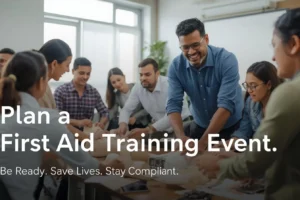Planning a first aid training session isn’t just another HR task — it’s an investment in employee safety and confidence. In Sri Lanka, workplaces in apparel, logistics, manufacturing, and even office settings are required to maintain trained first aid personnel under the Factories Ordinance No. 45 of 1942.
If your organization plans to invite an external certified trainer — such as the Sri Lanka Red Cross, St. John Ambulance Association, or National Institute of Occupational Safety and Health (NIOSH) — careful preparation ensures that the session is smooth, interactive, and achieves its learning goals.
This guide walks you through how to plan, organize, and evaluate a workplace first aid training event from start to finish.
1. Why Every Workplace Needs First Aid Training
Emergencies can happen anytime — a worker collapsing from heat exhaustion, a machine injury, or a heart attack in the office.
Immediate response from trained employees can save lives before medical help arrives.
According to the NIOSH Annual Report (2023), more than 8,000 workplace injuries were reported in Sri Lanka last year — with a significant number worsening due to delayed response.
First aid training builds a safety culture, reduces accident severity, and fulfills legal compliance.
➡️ External Source: National Institute of Occupational Safety and Health (NIOSH) Sri Lanka
2. Step-by-Step: How to Plan a First Aid Training Event
Step 1: Define the Objectives
Before contacting a trainer, decide what you want to achieve.
Ask questions like:
- What risks are most common in our workplace?
- How many employees should be trained?
- Should this be a basic awareness session or hands-on practical training?
Example:
“To train 30 factory workers in handling bleeding, burns, fainting, and CPR techniques.”
Clearly defined objectives help the external trainer tailor the content to your needs.
Step 2: Choose a Certified External Trainer
Select a recognized and experienced provider to ensure credibility and certification.
Recommended organizations in Sri Lanka include:
- Sri Lanka Red Cross Society (SLRCS) – offers basic and advanced workplace first aid.
- St. John Ambulance Association Sri Lanka – well-known for factory and office-based first aid.
- NIOSH – provides occupational health training and consultancy.
Always verify the trainer’s credentials and request a formal proposal or quotation.
Step 3: Set a Budget
A typical one-day training session costs between LKR 15,000 – 40,000, depending on:
- Number of participants
- Venue location
- Training duration
- Materials required (CPR mannequins, first aid kits, handouts)
Include additional costs for:
- Refreshments
- Certificates
- Equipment rental (projector, chairs, mats)
- Transportation for trainer or participants
Ensure the budget is approved early to avoid delays.
Step 4: Schedule the Training
Choose a date and time when operations are least disrupted — ideally during non-peak hours or a weekend half-day.
Confirm the session duration (usually 4–6 hours for basic training).
Notify staff at least two weeks in advance, so they can plan workloads and attendance.
Step 5: Select and Prepare the Venue
The venue should be:
- Spacious enough for demonstrations and group activities
- Well-lit and ventilated
- Equipped with a projector or screen
- Near accessible restrooms and emergency exits
If CPR or mock drills are planned, arrange floor mats and open space for participants to practice safely.
Step 6: Coordinate with the Trainer
Once confirmed, share essential details with the external trainer:
- Company profile and number of participants
- Identified workplace risks (e.g., machinery, chemicals, heat exposure)
- Preferred language (Sinhala, Tamil, or English)
- Available facilities (screen, sound system, first aid box, etc.)
Ask the trainer to provide:
- Training agenda or module outline
- Required materials or equipment list
- Certification process and validity period
Step 7: Communicate and Engage Participants
Send an internal announcement with:
- Purpose of the training
- Date, time, and venue
- Dress code (comfortable clothing)
- Contact person (usually HR or Safety Officer)
Create excitement — emphasize how the training can help employees protect themselves and their coworkers.
Step 8: Conduct the Training Event
On the day of training:
- Welcome participants and introduce the trainer
- Provide name tags or attendance sheets
- Ensure all equipment is ready before the session starts
- Assign someone to take photos for internal newsletters or CSR reporting
Encourage interaction — let participants practice skills like bandaging, recovery position, and CPR under supervision.
Step 9: Evaluate and Follow Up
At the end of the session:
- Distribute feedback forms
- Collect attendance records
- Issue completion certificates
Post-event, review:
- Did participants feel confident?
- Should more advanced sessions be scheduled?
- Were there any gaps (e.g., language, logistics, timing)?
Compile a training report summarizing attendance, outcomes, and recommendations for future sessions.
3. Maintaining First Aid Readiness
After training:
- Place first aid posters near work areas
- Ensure first aid boxes are restocked monthly
- Appoint trained first aid champions in each department
- Keep emergency numbers visible in all workplaces
Refresher sessions should be conducted every 12–18 months to maintain skills and legal compliance.

“First aid training isn’t just an event — it’s the start of a safety culture that saves lives.”
Conducting first aid training through an external trainer is one of the most cost-effective and impactful ways to strengthen workplace safety in Sri Lanka.
A well-planned event — from budgeting and venue setup to communication and evaluation — not only fulfills legal requirements but also builds a culture of care, teamwork, and responsibility.
When employees are empowered with first aid knowledge, they don’t just work safely — they work confidently.
4. Case Example: Logistics Company in Wattala
A mid-sized logistics firm organized a first aid training event with the St. John Ambulance Association for 40 warehouse staff.
The HR team planned the event in just two weeks:
- Scheduled on a Friday afternoon after deliveries
- Set up a warehouse section as the venue
- Provided snacks and hydration stations
- Issued certificates the same day
The result?
A 100% attendance rate and improved confidence among staff.
Later, two trained employees successfully managed a minor workplace accident before medical help arrived — proving the value of their investment.

Mr. Wajira Fernando
Group Manager - Human Resources
Puwakaramba Group of Company









